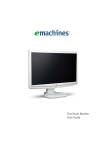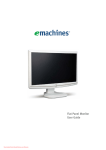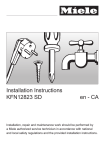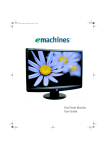Download eMachines E221HQ User guide
Transcript
Flat Panel Monitor User Guide Contents Using Your eMachines Flat-Panel Monitor . . . . . . . . . . . . . . . . . . . . . . . . . . . 1 Unpacking the monitor . . . . . . . . . . . . . . . . . . . . . . . . . . . . . . . . . . . . . . . . . . . . . . . . . . . . . 2 Setting up the monitor . . . . . . . . . . . . . . . . . . . . . . . . . . . . . . . . . . . . . . . . . . . . . . . . . . . . . 2 Attaching the base . . . . . . . . . . . . . . . . . . . . . . . . . . . . . . . . . . . . . . . . . . . . . . . . . . 2 Connecting cables . . . . . . . . . . . . . . . . . . . . . . . . . . . . . . . . . . . . . . . . . . . . . . . . . . . 3 Connecting a security cable . . . . . . . . . . . . . . . . . . . . . . . . . . . . . . . . . . . . . . . . . . 4 Turning on the monitor . . . . . . . . . . . . . . . . . . . . . . . . . . . . . . . . . . . . . . . . . . . . . . . . . . . . 4 Adjusting monitor settings . . . . . . . . . . . . . . . . . . . . . . . . . . . . . . . . . . . . . . . . . . . . . . . . . . 5 Monitor buttons . . . . . . . . . . . . . . . . . . . . . . . . . . . . . . . . . . . . . . . . . . . . . . . . . . . . 5 On-screen display options . . . . . . . . . . . . . . . . . . . . . . . . . . . . . . . . . . . . . . . . . . . 6 Changing Windows screen settings . . . . . . . . . . . . . . . . . . . . . . . . . . . . . . . . . . . 8 Power management . . . . . . . . . . . . . . . . . . . . . . . . . . . . . . . . . . . . . . . . . . . . . . . . . . . . . . . 9 ENERGY STAR . . . . . . . . . . . . . . . . . . . . . . . . . . . . . . . . . . . . . . . . . . . . . . . . . . . . . . . 9 Energy declaration . . . . . . . . . . . . . . . . . . . . . . . . . . . . . . . . . . . . . . . . . . . . . . . . . . 9 Maintaining . . . . . . . . . . . . . . . . . . . . . . . . . . . . . . . . . . . . . . . . . . . . . . . . . . . . . . . . . . . . . . 10 Troubleshooting . . . . . . . . . . . . . . . . . . . . . . . . . . . . . . . . . . . . . . . . . . . . . . . . . . . . . . . . . . 10 No power . . . . . . . . . . . . . . . . . . . . . . . . . . . . . . . . . . . . . . . . . . . . . . . . . . . . . . . . . 10 No picture . . . . . . . . . . . . . . . . . . . . . . . . . . . . . . . . . . . . . . . . . . . . . . . . . . . . . . . . . 10 Display colors are wrong . . . . . . . . . . . . . . . . . . . . . . . . . . . . . . . . . . . . . . . . . . . 11 Picture has shadows or “ghosts” . . . . . . . . . . . . . . . . . . . . . . . . . . . . . . . . . . . . . 11 Color is not uniform . . . . . . . . . . . . . . . . . . . . . . . . . . . . . . . . . . . . . . . . . . . . . . . . 11 Image is not sized or centered correctly . . . . . . . . . . . . . . . . . . . . . . . . . . . . . . 11 The monitor has pixels that are always dark or too bright . . . . . . . . . . . . . 12 Connecting a game console . . . . . . . . . . . . . . . . . . . . . . . . . . . . . . . . . . . . . . . . . 12 Specifications . . . . . . . . . . . . . . . . . . . . . . . . . . . . . . . . . . . . . . . . . . . . . . . . . . . . . . . . . . . . . 13 Video modes . . . . . . . . . . . . . . . . . . . . . . . . . . . . . . . . . . . . . . . . . . . . . . . . . . . . . . . 14 Safety, Regulatory, and Legal Notices . . . . . . . . . . . . . . . . . . . . . . . . . . . . . . 15 Recycling . . . . . . . . . . . . . . . . . . . . . . . . . . . . . . . . . . . . . . . . . . . . . . . . . . . . . . . . . . 17 i Contents ii Using Your eMachines Flat-Panel Monitor • • • • • • • • Unpacking the monitor Setting up the monitor Turning on the monitor Adjusting monitor settings Power management Maintaining Troubleshooting Specifications 1 Using Your eMachines Flat-Panel Monitor Unpacking the monitor Your monitor box should contain the following items: • Monitor (with neck attached) • Base (to connect to the neck) • This User Guide • VGA cable • DVI cable (optional) • Audio cable (optional) • Power cord If you are missing any items, call Customer Care. Setting up the monitor To set up the monitor, first attach the base, then connect cables. Attaching the base To attach the base: • Place the base on a table top, then press the base’s release button while you slide the monitor neck down onto the base. 2 www.emachines.com Connecting cables To connect video and power cables: 1 Position your computer and the monitor so you can reach the back of each, then connect the blue VGA video cable to the blue VGA video connector under the back of the monitor. 2 * Option for Dual Model Position your computer and the monitor so you can reach the back of each, then connect the white DVI video cable to the white DVI video connector under the back of the monitor. 3 Make sure that your computer is turned off, then connect the other end of the video cable to the matching video port on the back of your computer. 4 Connect the power cord to the power connector under the back of the monitor. 3 Using Your eMachines Flat-Panel Monitor 5 If you want to have your computer’s audio played through your monitor’s speakers, connect the included audio cable to your computer’s headphones or line out jack (usually color-coded green) and to your monitor’s AUDIO jack. Audio jack 6 Plug the power cord into a correctly grounded (three-prong) AC power outlet. We recommend using a surge protector to protect your monitor from voltage spikes. Connecting a security cable You can secure your monitor to your computer desk (or to another heavy object) with a cable lock (such as a Kensington™ lock). To connect a cable lock, follow the cable lock’s instructions to connect it to the lock slot on the back of your monitor (cable lock not included). Cable lock slot Turning on the monitor To turn on the monitor: 1 Press the power button on the front of your monitor. The power LED on the power button turns blue. (The appearance of your monitor may vary from that shown.) Power button Important Turn on your monitor before turning on your computer. 4 www.emachines.com 2 Turn on your computer. After your computer is running, the power LED on the monitor’s power button should be blue. Allow several seconds for the display image to appear. If the power LED is not on or is amber, or you do not see a display image, check the connections. For more troubleshooting information, see “Troubleshooting” on page 10. 3 Adjust the tilt of the monitor for the best viewing angle. The monitor can adjust from 15° back to 5° forward. Important When adjusting the monitor settings, always press Auto before entering the on-screen display menu (OSD). This will automatically adjust the display image to the ideal settings for the current screen resolution. 4 After you see the Windows desktop, press the Auto button on the bottom of the monitor to automatically adjust your display image to the ideal settings. 5 Use the on-screen display (OSD) to adjust other monitor settings. For more information, see “Adjusting monitor settings” on page 5. Adjusting monitor settings Use the monitor controls (located on the monitor itself) and computer controls (accessible through Windows) to adjust the display image. For more information about computer controls, see “Changing Windows screen settings” on page 8. Monitor buttons This monitor features an on-screen display (OSD) that lets you adjust contrast, brightness, and other settings for the monitor. The monitor saves changes you make to the settings, even if you turn off the monitor. (The appearance of your monitor may vary from that shown.) Bottom view Auto button Menu button < button > button • Auto button • • Press to have the monitor self-adjust its image position, clock, and focus settings. While the Scenario Mode menu is open, press to exit the menu. < and > buttons Press to adjust volume. (optional) While the OSD is open, press to highlight and adjust settings. Menu Press once to open or close the OSD and select the highlighted menu or setting. 5 Using Your eMachines Flat-Panel Monitor On-screen display options Adjusting OSD settings To adjust the OSD settings: 1 Press Auto. The display image is automatically adjusted to the ideal settings for your current screen resolution. 2 Press Menu. The OSD opens. 3 Press < and > to highlight a setting, then press Menu to open the selected menu or setting. You can configure settings in the following menus: Menu icon Name Description Brightness and Contrast Adjusts the brightness and contrast (by selecting User) or selects a color mode (by selecting Scenario Mode). Focus and Clock Adjusts focus and clock settings. Position Adjusts horizontal and vertical screen image position. Color Temperature Selects a warm, cool, or user-defined color temperature. Language Selects the language for the OSD. OSD Settings Adjusts the horizontal and vertical position of the OSD and sets the timeout. Input Source Select input signal from D-Sub or DVI-D or HDMI Select Wide mode setting for Full screen, Aspect ratio or 1:1 mode Turns DDC/CI support on or off. Wide Mode DDC/CI Settings Mode Information Displays the monitor’s current resolution, timing, input type, and serial number. Reset to Defaults Resets all OSD settings to defaults. Exit Exits the OSD. 4 Press < and > to adjust the setting to the desired level or change the option. 5 When you have finished making all adjustments, press Auto repeatedly to exit. 6 www.emachines.com To set the scenario mode: 1 Press Menu to open the OSD, then press Menu again to select the Brightness and Contrast menu. 2 Press > to highlight Scenario Mode, then press Menu. The Scenario Mode menu opens. 3 Press < and > to highlight a scenario mode, then press Auto to keep the setting. Menu icon Mode Description User User-defined (custom) settings, which can be adjusted to suit your needs. Text This is the best balance of brightness and contrast to prevent eye strain while reading on-screen text. Standard This uses default settings, and is the best general-purpose mode. Graphic This enhances color and emphasizes fine detail. Movie This displays full-motion scenes in the clearest detail. 7 Using Your eMachines Flat-Panel Monitor Changing Windows screen settings Color depth and screen resolution are two of the most basic monitor settings you may need to change to suit your needs. Color depth is the number of colors your computer uses to display images on your monitor. Most images look best displayed with the maximum number of colors available. If the color in your images seems “false” or “jumpy,” especially after you have played a game or run a video-intensive program, check the color depth setting and return it to the highest color setting, if necessary. Common color depth settings include: • Low (8-bit) = 256 colors • Medium (16-bit) = 65,500 colors • Highest (32-bit) = 16,700,000 colors Screen resolution is the number of pixels (individual colored dots) your computer uses to display images on your monitor. The higher the resolution, the more information and screen components (such as icons and menu bars) can be displayed on the monitor. Help For more information about adjusting the screen, click Start, then click Help and Support. Type adjusting monitor settings in the Search Help box, then press ENTER. To change the color depth and screen resolution in Windows Vista®: (Start), Control Panel, then under Appearance and Personalization, click Adjust Screen Resolution. The Display Settings dialog box opens. 1 Click Shortcut You can also right-click on your Windows desktop, then click Personalize. 2 To change the color depth, click the Colors list, then click the color depth you want. 3 To change the screen resolution, drag the Resolution slider to the size you prefer. 4 Click Apply. If the new settings do not look right, click No. If the new settings make the screen illegible and you cannot click No, the settings return to their previous values after several seconds. 5 Click OK, then click Yes to save your changes. To change the color depth and screen resolution in Windows XP: 1 Click Start, then click Control Panel. The Control Panel opens. If your Control Panel is in Category View, click Appearance and Themes. Shortcut You can also right-click on your Windows desktop, then click Properties. 2 Click Display. The Display Properties dialog box opens. 3 Click the Settings tab. 4 To change the color depth, click the arrow button to open the Color quality list, then click the color depth you want. 5 To change the screen resolution, drag the Screen resolution slider to the size you prefer, then click OK. 8 www.emachines.com Power management ENERGY STAR® Acer’s ENERGY STAR qualified products save you money by reducing energy costs and helps protect the environment without sacrificing features or performance. Acer is proud to offer our customers products with the ENERGY STAR mark. What is ENERGY STAR? Products that are ENERGY STAR qualified use less energy and prevent greenhouse gas emissions by meeting strict energy efficiency guidelines set by the U.S. Environmental Protection Agency. Acer is committed to offer products and services worldwide that help customers save money, conserve energy and improve the quality of our environment. The more energy we can save through energy efficiency, the more we reduce greenhouse gases and the risks of climate change. More information refers to http://www.energystar.gov or http://www.energystar.gov/powermangement Acer ENERGY STAR qualified products: Produce less heat and reduce cooling loads, and warmer climates. Automatically go into “display sleep” and “computer sleep” mode after 15 and 30 minute of inactivity respectively. Wake the monitor when it is in Active Off mode, move the mouse or press any keyboard key. Computers will save more than 80% energy at “sleep” mode. ENERGY STAR and the ENERGY STAR mark are registered U.S. marks Energy declaration When connected to a computer that supports the VESA Display Power Management Signaling (DPMS) protocol, the monitor can conserve significant energy by reducing power consumption during periods of non-use. When your computer goes into the energy-saving mode, the monitor enters the Active Off mode (sleep). In the Active Off mode the power LED turns amber. Use these conventions and the power can be reduced to the following levels: VESA state LED indicator On Blue Active Off Amber Power consumption 36 W 2W To “wake” the monitor when it is in Active Off mode, move the mouse or press any keyboard key. Access the power management options in the Control Panel to change the period of time after which the monitor enters these low power states. 9 Using Your eMachines Flat-Panel Monitor Maintaining To keep the monitor in optimal working order: • Do not block the ventilation holes. • Do not expose the monitor to rain or use near water. • Keep the monitor away from radiators or heat vents. • Keep the monitor out of direct sunlight. Caution Do not use any type of abrasive pad or glass cleaner. You will permanently scratch the screen. • To clean the monitor, use a soft cloth slightly moistened with water only. Wipe the cabinet, screen, and controls. Troubleshooting Important Make sure that the monitor has warmed up for about 30 minutes before making any judgments about the picture quality. The screen’s backlight can take several minutes to reach maximum brightness. If you have problems with the monitor, the information in this troubleshooting section may help you solve them. No power • Make sure that the power cord is connected correctly to both the back of the monitor and an AC power outlet. For more information about connecting the power cord, see “Setting up the monitor” on page 2. No picture • Make sure that the power cord is connected correctly to both the back of the monitor and • • • 10 an AC power outlet. For more information about connecting the power cord, see “Setting up the monitor” on page 2. Make sure that the video cable is connected securely to the back of the monitor and the computer. For more information about connecting the video cable, see “Setting up the monitor” on page 2. Make sure that the monitor is turned on. If you have the monitor connected to your notebook’s video port, you have two options: • If your notebook supports dual displays, you can use both your notebook’s display and this monitor in extended desktop multi-monitor mode. See Windows Help to learn how to enable multiple monitors. • You can also use this monitor as your primary monitor and not use the notebook’s screen. Notebook computers typically have an FN key combination that lets you toggle between your notebook’s display, an externally attached display, and both at the same time. See your notebook’s user guide for more information. www.emachines.com • If the power LED is amber: • Make sure that your computer is turned on. • Move the mouse or press any key on the keyboard to bring the monitor out of sleep mode. • Restart your computer with the monitor turned on. • Make sure that the video cable is not damaged. • Check the end of the video cable for any pins that might be bent or pushed in. • Turn off the monitor and unplug the video cable from the back of your computer. Turn the monitor back on and wait for ten seconds. If the monitor is functioning correctly, a “Cable Not Connected” message appears. For more information about connecting the video cable, see “Setting up the monitor” on page 2. Display colors are wrong • Press Auto to automatically adjust the display image to the ideal settings. • Restart your computer with the monitor turned on. • Make sure that the video cable is connected securely to the back of the monitor and your • • computer. For more information about connecting the video cable, see “Setting up the monitor” on page 2. Make sure that the video cable is not damaged. Check the end of the video cable for any pins that might be bent or pushed in. Picture has shadows or “ghosts” • Press Auto to automatically adjust the display image to the ideal settings. • Remove any extension cables or switchboxes. • Make sure that the video cable is connected securely to the back of the monitor and your computer. For more information about connecting the video cable, see “Setting up the monitor” on page 2. Make sure that the video cable is not damaged. Check the end of the video cable for any pins that might be bent or pushed in. • • • Make sure that your monitor connection is using the VGA cable that came with your monitor. Color is not uniform • Press Auto to automatically adjust the display image to the ideal settings. • Make sure that the monitor warms up for at least 30 minutes before making a final judgment about color uniformity or brightness. Image is not sized or centered correctly • Press Auto to automatically adjust the display image to the ideal settings. • Change the position settings. For instructions on how to adjust the display image position, see “Adjusting monitor settings” on page 5. 11 Using Your eMachines Flat-Panel Monitor • If the image looks stretched or fuzzy, you must adjust the operating system’s display settings • • to match the monitor’s optimal (native) setting. For information on adjusting settings, see “Changing Windows screen settings” on page 8. To find your monitor’s native setting, see “Specifications” on page 13. If you are trying to select your monitor’s native resolution but it is not available in the Windows display control panel: • Make sure that your video card can display at your monitor’s native resolution. • This may be caused by older video drivers on your computer. See the eMachines support Web site (www.emachines.com) for updated video drivers for your computer. You can also go directly to your video card’s support Web site for the most up-to-date video drivers. If your games do not have support for widescreen displays: • Newer games are adding support for widescreen displays as the widescreen format becomes more popular. Check the game’s Web site for updates. You can also consult the following Web site for specific settings and options to configure older games to support widescreen: www.widescreengamingforum.com. • Some adjustments may require you to make changes to the Windows System Registry. We recommend making a complete system backup before changing the System Registry. The monitor has pixels that are always dark or too bright • This condition is normal and inherent in the TFT technology used in active-matrix LCD screens. eMachines’ inspection standards keep these to a minimum. If you feel these pixels are unacceptably numerous or dense on your display, contact eMachines Customer Care to identify whether a repair or replacement is justified based on the number of pixels affected. Connecting a game console • To determine the type of cable you need, see your gaming console’s documentation. 12 Using Your eMachines Flat-Panel Monitor Specifications Specifications are subject to change without notice or obligation. Many products for eMachines are custom engineered by our suppliers to eMachines specifications and may vary from similarly marketed products. Panel size and type Pixel resolution Pixel pitch Aspect ratio Brightness and contrast ratio Viewing angles Response time Lamp type/life Colors 21.5 inch (diagonal) UXGA TFT 1920 ×1080 (native) 0.0976 × 0.0976 inches (0.248 mm × 0.248 mm) 16:9 300 cd/m2, 20000:1 Max , (Dynamic) 160° horizontal, 160° vertical 5 ms 40,000 hours 16.7 million Audio output 1W x 2 (Option) OSD languages EMEA: English, French, German, Spanish, Italian, Dutch, Finnish, Russian non-EMEA: Japanese, Traditional Chinese, Simplified Chinese, English, French, German, Spanish, Italian n Russia: Russian Analog (VGA): 15-pin d-sub VGA n n Connections and inputs AC power Included cables 15-pin d-sub analog VGA Power consumption Normal: <36 W, Sleep <2 W, Off (power-save): <1 W AC power Power input AC100-240 V, 50/60 Hz Power management Energy Star® Certifications CB, cTUVus,TUV/GS,ERGO,CCC,CE,C-TICK,FCC VCCI,TCO03,BSMI ,NOM,GOST Wall mount bracket VESA 3.937 × 3.937 inches (100 × 100 mm) Dimensions with basic stand 17.33 × 14.14 × 7.09 inches (44.02 × 35.91 × 18.01 cm) 13 www.emachines.com Video modes E211H/E221HQ Mode Mode name and resolution 1 VGA 640x480@60Hz 2 MAC [email protected] 3 Horizontal frequency (kHz) Vertical frequency (Hz) 31.469 59.941 35 66.66 VESA 720x400@70Hz 31.469 70.087 4 SVGA 800x600@56Hz 35.156 56.250 5 SVGA 800x600@60Hz 37.879 60.317 6 7 XGA 1024x768@60Hz 48.363 60.004 XGA 1024x768@70Hz 56.476 70.069 8 VESA 1152x864@75Hz 67.5 75 9 SXGA 1280x1024@60Hz WXGA 1280x800@60Hz 63.981 49.702 60.020 59.810 10 11 WXGA+ 1440x900@60Hz 55.935 59.887 12 USGA 1920x1080@60Hz 67.158 59.963 13 UXGA 1920x1080@60Hz 67.500 60.000 14 Safety, Regulatory, and Legal Notices • • • • Important safety information Environmental information Regulatory compliance statements Notices 15 Safety, Regulatory, and Legal Notices Important safety information Warning Always follow these instructions to help guard against personal injury and damage to your product. Warning Do not use eMachines products in areas classified as hazardous locations. Such areas include patient care areas of medical and dental facilities, oxygen-laden environments, or industrial facilities. Your eMachines product is designed and tested to meet the latest standards for safety of information technology equipment. However, to ensure safe use of this product, it is important that the safety instructions marked on the product and in the documentation are followed. Setting up your system ■ ■ ■ ■ ■ ■ ■ ■ Read and follow all instructions marked on the product and in the documentation before you operate your system. Retain all safety and operating instructions for future use. Do not use this product near water or a heat source such as a radiator. Set up the system on a stable work surface. The product should only be operated from the type of power source indicated on the rating label. If your product has a voltage selector switch, make sure that the switch is in the proper position for your area. The voltage selector switch is set at the factory to the correct voltage. Openings in the monitor case are provided for ventilation. Do not block or cover these openings. Make sure you provide adequate space, at least 6 inches (15 cm), around the system for ventilation when you set up your work area. Never insert objects of any kind into the monitor ventilation openings. Some products are equipped with a three-wire power cord to make sure that the product is properly grounded when in use. The plug on this cord will only fit into a grounding-type outlet. This is a safety feature. If you are unable to insert the plug into an outlet, contact an electrician to install the appropriate outlet. If you use an extension cord with this system, make sure that the total ampere rating on the products plugged into the extension cord does not exceed the extension cord ampere rating. Care during use Warning To prevent electric shock, never remove the cover. No user serviceable parts inside. Refer servicing to qualified service personnel. ■ ■ ■ ■ ■ Do not walk on the power cord or allow anything to rest on it. Do not spill anything on the system. The best way to avoid spills is to avoid eating and drinking near your system. Do not expose the monitor to rain or use near water. If the monitor does get exposed to moisture, unplug it and allow it to dry for 24 hours. Call eMachines Customer Care for advice on whether the monitor is safe to turn back on. When the monitor is turned off, a small amount of electrical current still flows through the monitor. To avoid electrical shock, always unplug all power cables and modem cables from the wall outlets before cleaning the system. Unplug the system from the wall outlet and refer servicing to qualified personnel if: ■ The power cord or plug is damaged. ■ Liquid has been spilled into the system. ■ The system does not operate properly when the operating instructions are followed. ■ The system was dropped or the cabinet is damaged. ■ The system performance changes. Replacement parts and accessories Use only replacement parts and accessories recommended by eMachines. 16 www.emachines.com Environmental information Recycling Mercury Warning Hg Lamp(s) inside this product contain mercury and must be recycled or disposed of according to local, state, or federal laws. The product you have purchased contains extracted natural resources that have been used in the manufacturing process. This product may contain substances known to be hazardous to the environment or to human health. To prevent releases of harmful substances into the environment and to maximize the use of our natural resources, eMachines provides the following information on how you can responsibly recycle or reuse most of the materials in your “end of life” product. Waste Electrical and Electronic Equipment (commonly known as WEEE) should never be disposed of in the municipal waste stream (residential garbage collection). The “Crossed-Out Waste Bin” label affixed to this product is your reminder to dispose of your “end of life” product properly. Substances such as glass, plastics, and certain chemical compounds are highly recoverable, recyclable, and reusable. You can do your part for the environment by following these simple steps: When your electrical or electronic equipment is no longer useful to you, “take it back” to your local or regional waste collection administration for recycling. In some cases, your “end of life” product may be “traded in” for credit towards the purchase of new eMachines equipment. Call eMachines to see if this program is available in your area. N If you need further assistance in recycling, reusing, or trading in your “end of life” product, you may contact us at the Customer Care number listed in your product’s user guide and we will be glad to help you with your effort. Finally, we suggest that you practice other environmentally friendly actions by understanding and using the energy-saving features of this product (where applicable), recycling the inner and outer packaging (including shipping containers) this product was delivered in, and by disposing of or recycling used batteries properly. N N With your help, we can reduce the amount of natural resources needed to produce electrical and electronic equipment, minimize the use of landfills for the disposal of “end of life” products, and generally improve our quality of life by ensuring that potentially hazardous substances are not released into the environment and are disposed of properly. For additional recycling information specific to your area, please go to http://www.acer-group.com/public/Sustainability/sustainability01.htm http://www.acer-group.com/public/Sustainability/sustainability04.htm 17 $FHU$PHULFD&RUSRUDWLRQ :HVW6DQ&DUORV6W6DQ-RVH &$86$ 7HO )D[ ZZZDFHUFRP )HGHUDO&RPPXQLFDWLRQV&RPPLVVLRQ 'HFODUDWLRQRI&RQIRUPLW\ 7KLV GHYLFH FRPSOLHV ZLWK 3DUW RI WKH )&& 5XOHV 2SHUDWLRQ LV VXEMHFW WR WKH IROORZLQJWZRFRQGLWLRQVWKLVGHYLFHPD\QRWFDXVHKDUPIXOLQWHUIHUHQFHDQG WKLV GHYLFH PXVW DFFHSW DQ\ LQWHUIHUHQFH UHFHLYHG LQFOXGLQJ LQWHUIHUHQFH WKDW PD\ FDXVHXQGHVLUHGRSHUDWLRQ 7KHIROORZLQJORFDO0DQXIDFWXUHU,PSRUWHULVUHVSRQVLEOHIRUWKLVGHFODUDWLRQ 3URGXFW 21.5"/&'0RQLWRU 0RGHO1XPEHU (211+(221+4 6.81XPEHU (211+[[[(221+4[[[ ³[´ aDa]$a=RU%ODQN 1DPHRI5HVSRQVLEOH3DUW\ $FHU$PHULFD&RUSRUDWLRQ $GGUHVVRI5HVSRQVLEOH3DUW\ :HVW6DQ&DUORV6W 6DQ-RVH&$ 86$ &RQWDFW3HUVRQ $FHU5HSUHVHQWDWLYH 3KRQH1R )D[1R $FHU,QFRUSRUDWHG )6HF+VLQ7DL:X5G+VLFKLK 7DLSHL+VLHQ7DLZDQ 'HFODUDWLRQRI&RQIRUPLW\ :H $FHU,QFRUSRUDWHG )6HF+VLQ7DL:X5G+VLFKLK7DLSHL+VLHQ7DLZDQ &RQWDFW3HUVRQ0U(DV\/DL 7HO)D[ (PDLOHDV\BODL#DFHUFRPWZ +HUHE\GHFODUHWKDW 3URGXFW 7UDGH1DPH 0RGHO1XPEHU 6.81XPEHU 21.5#/&'0RQLWRU HMDFKLQHV (211+(221+4 (211+[[[(221+4[[[ ³[´ aDa]$a=RU%ODQN ,VFRPSOLDQWZLWKWKHHVVHQWLDOUHTXLUHPHQWVDQGRWKHUUHOHYDQWSURYLVLRQVRIWKHIROORZLQJ(&GLUHFWLYHV DQG WKDW DOO WKH QHFHVVDU\ VWHSV KDYH EHHQ WDNHQ DQG DUH LQ IRUFH WR DVVXUH WKDW SURGXFWLRQ XQLWV RI WKH VDPHSURGXFWZLOOFRQWLQXHFRPSO\ZLWKWKHUHTXLUHPHQWV (0&'LUHFWLYH(&DVDWWHVWHGE\FRQIRUPLW\ZLWKWKHIROORZLQJ KDUPRQL]HGVWDQGDUGV (1$61=6&,635&ODVV% (1$$ (1&ODVV' (1$$ /RZ 9ROWDJH 'LUHFWLYH (& DV DWWHVWHG E\ FRQIRUPLW\ ZLWK WKH IROORZLQJ KDUPRQL]HGVWDQGDUG (1$ 5R+6'LUHFWLYH(&RQWKH5HVWULFWLRQRIWKH8VHRIFHUWDLQ+D]DUGRXV 6XEVWDQFHVLQ(OHFWULFDODQG(OHFWURQLF(TXLSPHQW <HDUWREHJLQDIIL[LQJ&(PDUNLQJ )HE16 (DV\/DL0DQDJHU 5HJXODWLRQ$FHU,QF 'DWH


































